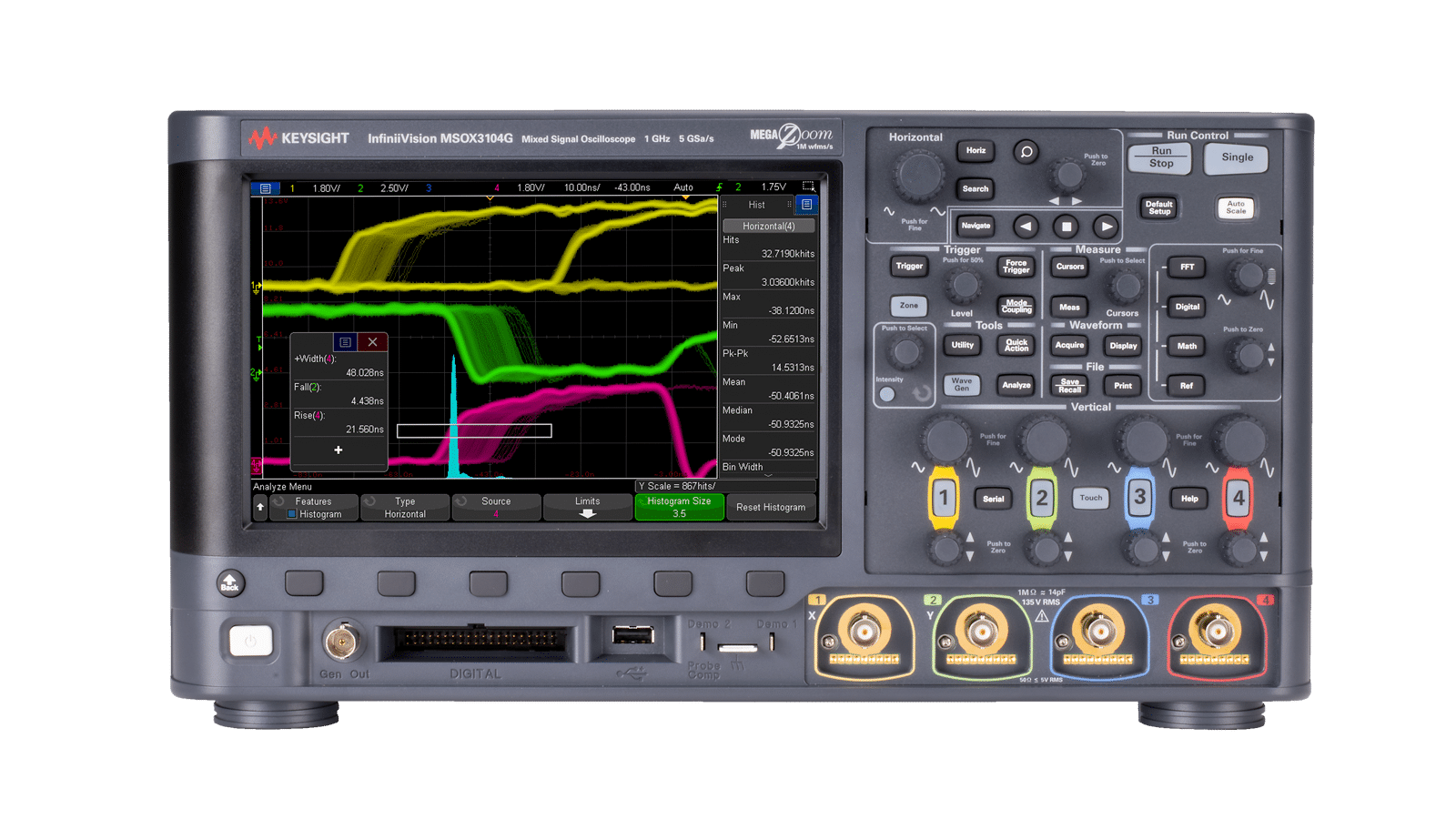The design of test and measurement devices has long been based on the parameters of memory capacity, measurement speed, and sampling rate. However, major test equipment manufacturers are now seeing engineers turn to "time to solve" as a key factor in selecting equipment.
By Cliff Ortmeyer, Global Head of Technical Marketing at Farnell
When evaluating the selection of currently available test instruments from the standpoint of paper specifications, an engineer has numerous options. It is inevitable that there will be applications that require a level of sampling and bandwidth that only certain instruments can offer. However, for many applications the most important thing is whether the instrument can quickly help solve a problem, rather than whether it can, in principle, provide the required basic performance.
“At my last count, there were 35 models of 1 GHz discrete oscilloscopes available for sale on the market today from different manufacturers. It's crazy,” says Mike Hoffman, Product Manager at Keysight Technologies.
Data sheet specifications, which allow so many manufacturers to compete in the same space, only provide information on a small part of what an instrument can do for a team. The true value of a test and measurement instrument lies in the combination of its signal handling capabilities and its ability to help engineers solve problems. These two factors must be in line for the user to achieve the resolution time he needs. The faster a user can set up measurements, get the data, and analyze the results, the sooner a problem can be found and fixed. This creates a strong incentive for instrument manufacturers to offer easy-to-use and intuitive features, thus minimizing time to solve.
"If we can make our products easier to use than the competition we will have a huge advantage because engineers won't have to spend as much time understanding the test equipment and can focus on understanding the design they are working on," says Brad Odhner, Technical Marketing Manager for Tektronix and Keithley Instruments.
The definition of the usability of the test equipment begins with a practical case
There are many factors that influence the ease of use of an instrument. One of them is to be familiar with the instrument. Typically, different products from the same manufacturer work in a very similar way, or at least follow similar patterns of user experience. Therefore, many laboratories choose to purchase from the same manufacturer to ensure familiarity and reduce the learning curve associated with using each different class of instrument.
Familiarity is most useful in repeated measures. However, it may limit product options and may not offer the best value for money. Rather, change carries an unavoidable cost. Users should spend time getting familiar with the features and interface. Some manufacturers have responded to this dilemma by investing heavily in making their user interfaces as intuitive as possible and reducing learning time for any given feature. The goal is for engineers using the product for the first time to quickly understand how to navigate the menus and set up the necessary tests.
“We strive to understand different user segments and make using the product intuitive from the moment you pick it up. The customer in question may be a highly-skilled technician or engineer, but understanding the workflow and what you need to do with this product is critical,” explains Justin Sheard, Fluke Principal Engineer for New Product Solutions.
Understanding the different cases greatly influences the effectiveness of an instrument in the real world. Let's think about the possibility of using the instruments in the field and not in the laboratory. Some benchtop oscilloscopes are portable in that they are relatively light and come with a handle. However, a truly portable product must cover other needs.
“The approach is totally different when building a portable or benchtop product. Completely different aspects must be taken into account. For example, for a bench product, accuracy and speed must be evaluated. You need to have LabVIEW integration and things like that,” says Kai Scharrmann, Head of Sales at Hioki Europe. “Instead, portable options should focus on ease of use and a rugged design. The approach is different, but the measurement principle and technology are the same.”
Regardless of the approach and intended use, equipment manufacturers agree that prioritizing usability is now non-negotiable.
Screens: How important is size?
Some design decisions are valid for practically all kinds of instruments. One of those factors is the size of the screen. It is important to have a clear view of the waveform being analyzed. Normally, the larger the screen, the better the visualization and the easier to identify the problem that you want to detect. Although the largest screens are often associated with the largest instruments, some large screen oscilloscopes have very compact housings. Also, a larger screen allows for on-screen controls that are touch sensitive, while off-screen buttons can be more confusing if the instrument has multiple modes that change the action performed by the physical buttons.
“Computer use offers another way to optimize screen size,” says Mike Purday, Regional Manager for EMEA at Pico Technology. “Display options are one of the biggest advantages to using a PC-based oscilloscope as the variety of options is vastly increased compared to desktop oscilloscopes. For example, you may want to use a 65-inch ultra-high-definition display so you can drill down into signal detail.
This can easily be achieved with test equipment connected to a computer.”
Computer-based instruments may be optimal in portable use cases where engineers are expected to use a laptop in conjunction with the test instrument. Software running on the host computer can provide field access to advanced tools such as LabVIEW. "It's much easier to share data between teams that may be working remotely," adds Purday, noting that the computer often offers a number of network connectivity options.
The trend towards integration
That said, computer-based instruments aren't the only ones that offer connectivity benefits. An increasing number of portable instruments incorporate wireless connectivity to facilitate access to cloud services. The integration of the measurement functions results in an improvement of usability in a wide range of instruments. Many products available today feature powerful processors and large memory options that allow operations that previously required a separate computer. Hoffman says that it can be helpful for engineers to examine the applications that their instrument should ideally support: “Am I running some kind of specialized power measurement? Am I working with a specific serial bus that I want to decode?
The ability to perform these measurements on the instrument can save significant time when debugging problems. For example, on-board serial bus decoding can quickly display protocol errors that will help diagnose a problem. For example, on-board serial bus decoding can quickly display protocol errors that will help diagnose a problem. Very often these embedded applications take advantage of functional integration, such as combining oscilloscope and logic analyzer operations.
“A standalone logic analyzer will far outperform any kind of similar features of a mixed-signal oscilloscope. But if you only need a square wave once in a while, you no longer have to buy a separate box and have it calibrated and maintained, because your oscilloscope includes a basic generator. It can be as simple as plugging into a jack on the front of the oscilloscope and pressing the 'Go' button,” explains Hoffman.
According to Odhner, another important area of integration with basic oscilloscope functions is RF and power analysis. “We have added a digital downconverter on every channel of our 4, 5, and 6 series oscilloscopes. This allows you to look at the same signal both in the time domain and in the frequency domain across every channel of that oscilloscope. This creates an oscilloscope that can also function as a spectrum analyzer. Consolidation makes sense because often an engineer needs to find a frequency-domain anomaly that occurs in a time-domain signal.”
Helping engineers solve problems quickly has become a key factor in the design of new test products, in addition to the already important features such as resolution, memory capacity, and sample rate parameters that they offer. their designs. Manufacturers are investing heavily in R&D of user interfaces, larger screens, application compatibility, and measurement integration, among other things, making resolution time the key parameter when selecting new equipment. Test engineers who make their decisions based on time to solve are sure to reap the benefits.






